Is it possible to overclock the computer screen? How like?
Computer monitors can also be overclocked
Overclocking or overclocking the screen basically has the same purpose as overclocking the processor, in order to increase performance. More specifically, overclocking the screen is to increase the refresh rate (refresh rate) based on the original rate, which means that more frames can be "drawn" on the screen every second.
Overclocking a computer screen is not necessarily all people need, but it is not too difficult a trick to perform or something so dangerous that you should not do. Here's what you need to know about overclocking your PC screen.

Default refresh rate of the screen
What is the refresh rate?
The definition of refresh rate or refresh rate is as follows: The number of times the image displayed on the screen needs to be recreated every second to avoid blinking when viewed with the naked eye.
That is, a 60Hz screen will refresh the image 60 times per second, 75Hz is 75 times per second, 144Hz is 144 times per second. In general, especially in the field of computing and gaming, this ratio is as high as possible. The human and brain eyes see about 24 frames per second, but we can see that the refresh rate is much greater than that.
You can refer to Refresh rate here: What does the Refresh Rate parameter on the computer screen, TV mean?
Any screen can be overclocked?
Bad luck. Whether to increase the refresh rate or not, it still depends on the specific control panel. Even in identical displays, the screen panel is still not the same. You can see your screen is significantly improved after overclocking, but your screen is not so lucky.
For example, a computer using BenQ RL2455HM and many people have reported overclocking it from 60Hz to 75Hz, but there are also people who only press up to 70Hz.
Note: Please take every step to check the control panel specifications first, because not all control panels are the same. Moreover, it is possible that manufacturers have overclocked the screen, in this case, if you try to push the refresh rate even higher, there may be risks.
How to overclock the screen?
This is a not so complicated process, you can use CRU tools or try out software from AMD, NVIDIA or Intel. All of them are free. Below, we will review them one by one.
Use CRU - Custom Resolution Utility
This is one of the older methods and may not be compatible with all integrated Intel GPUs or graphics. However, it seems to work very well with AMD graphics. You can download it here: https://www.monitortests.com/cru-1.3.zip and after installing, follow these instructions to overclock the screen.
- Open CRU.
- You will see 2 options, 1 for detailed resolutions and 1 for standard resolutions.
- Under Detailed solutions click Add .
- Click Timing and change it to LCD standard .
- Change Refresh rate to a value higher than the standard value, the best way is to increase the 5Hz one.
- Click OK .
- Restart the computer.
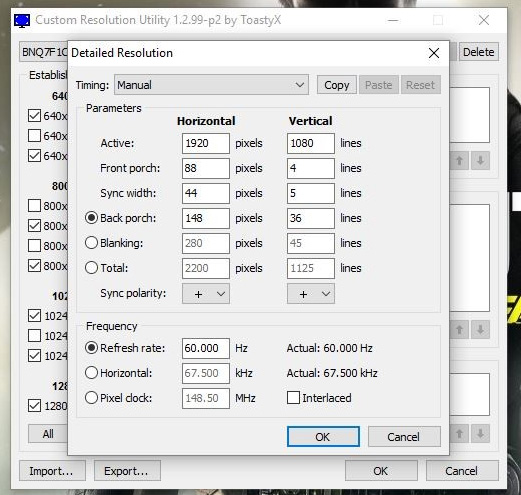
Interface of CRU when changing parameters of computer screen
Next you need to change the refresh rate in Windows 10, these steps are applied to all overclocking methods below *:
- Right click on the desktop and select Display settings .
- Click on Advanced display settings .
- Scroll down and select Display adapter properties .
- On the Monitor tab, select the desired refresh rate.
If successful, the screen will not be black. If you overclock the screen beyond its capabilities, it will not display anything and return to the old settings after 15 seconds.
Use AMD Radeon Settings
If using an AMD GPU, you can overclock your computer screen using the AMD Radeon Settings application. Right-click its icon in the taskbar and follow these steps:
- Right-click on the desktop and select AMD Radeon Settings .
- Select the Display tab.
- Select Custom resolutions > Create .
- Change Refresh rate to the desired level.
- Click Save .
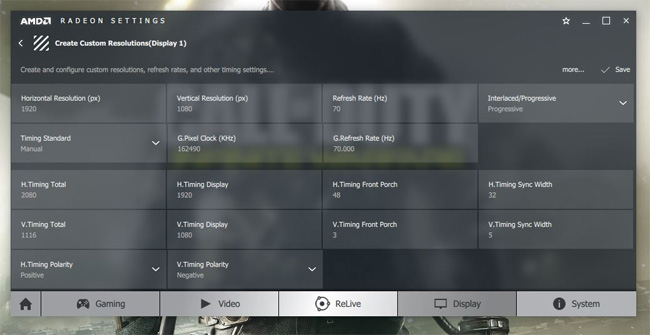
Use AMD Radeon Settings to overclock the screen
Restart and use the steps above (*) to change the refresh rate on Windows 10.
Use the NVIDIA Control Panel
The steps for NVIDIA users are quite similar to AMD, with the main difference being that NVIDIA's control panel looks more convenient.
- Right-click the desktop and select NVIDIA Control Panel .
- Expand the Display menu.
- Click Change Resolution > Create Custom Resolution .
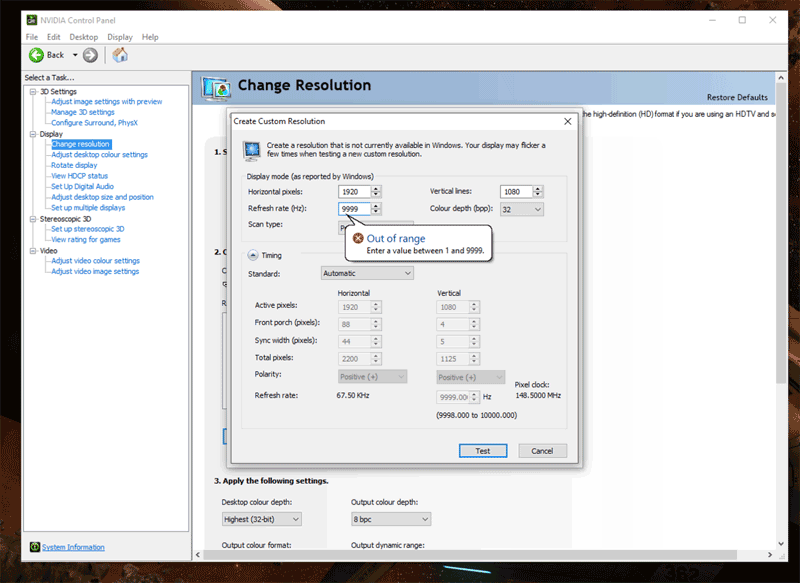
Overclock the screen with the NVIDIA Control Panel
With NVIDIA Control Panel you can check the settings that were created before applying them. When satisfied, restart and follow the steps * to complete.
Use Intel Graphics
Using Intel's HD Graphics Control Panel will help you customize screen resolution and refresh rate quite easily:
- Open Intel's HD Graphics Control Panel.
- Select Display .
- Click on Custom Resolutions .
- Enter the width, height and refresh rate you want.
- Click Add .
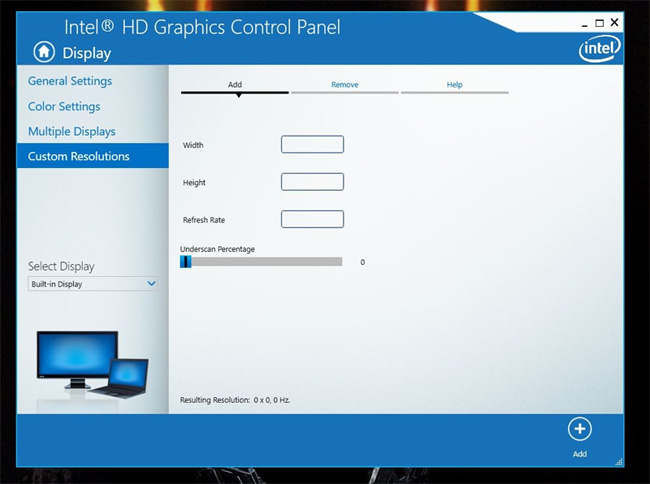
Overclock the screen with Intel's HD Graphics Control Panel
If the screen cannot reach the resolution you have customized, it will display a message, you will have to exit or try again with a lower resolution. If successful overclocking, restart and perform the steps * to complete.
How do I know if I have overclocked the screen successfully?
To check and make sure that the refresh rate you just created is working as expected, go here: http://www.testufo.com/#test=frameskipping and follow the on-screen instructions. It will recognize the refresh rate of the screen you selected at that time.
If the black cells on a line are not interrupted, you have successfully overclocked and vice versa.
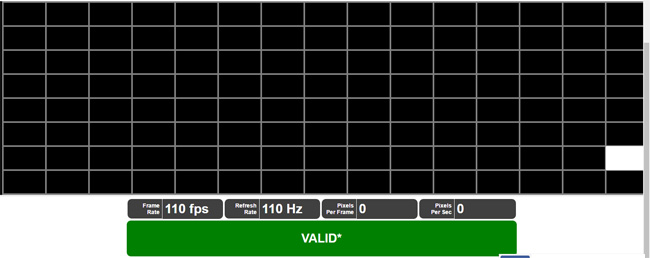
The black boxes are as seamless as the picture was successful
Just like overclocking the CPU, overclocking the computer screen depends a lot on luck. You can experiment without increasing the refresh rate, but there may be some risks, so be careful when doing so.
If you have overclocked the screen and have useful experiences, please share with me and other readers by commenting below the article!
You should read it
- Instructions for overclocking the CPU
- Instructions to overclock computer RAM
- Overclock CPU, GPU and RAM easily and safely
- Everything you need to know about overclocking your Raspberry Pi 5
- 6 best overclocking software to boost PC performance
- Things to know about overclocking computers
- How to overclock Raspberry Pi 4
- Instructions for overclocking graphics cards for better gaming performance
May be interested
- 6 Reasons OCCT is the Favorite Tool for Stress Testing CPUs and GPUs
 there are many stress testing apps out there, but one option stands out – occt (overclock checking tool). here's why…
there are many stress testing apps out there, but one option stands out – occt (overclock checking tool). here's why… - 5 tips to help make optimal use of Tomato on the Router
 in the following article, we will show you the 5 most useful tips for tomato, which help speed up your router and your work is done faster.
in the following article, we will show you the 5 most useful tips for tomato, which help speed up your router and your work is done faster. - How to overclock GPU to optimize computer performance
 overclocking your gpu is a popular way to increase the performance of your graphics card, increasing the speed of image and video processing. this article will guide you in detail on how to do it.
overclocking your gpu is a popular way to increase the performance of your graphics card, increasing the speed of image and video processing. this article will guide you in detail on how to do it. - Instructions to overclock computer RAM
 factory ram is often slow, but with a few minutes of bios editing and testing, you can make the memory run faster than the manufacturer's specifications.
factory ram is often slow, but with a few minutes of bios editing and testing, you can make the memory run faster than the manufacturer's specifications. - What are the harmful effects of overclocking a graphics card?
 you should consider carefully before deciding to overclock your graphics card.
you should consider carefully before deciding to overclock your graphics card. - AMD Ryzen Master stops supporting Threadripper and Ryzen 1st and 2nd generation CPUs, users take note!
 last month, amd released a new version of ryzen master, an application that helps tweak and overclock ryzen and threadripper-branded processors.
last month, amd released a new version of ryzen master, an application that helps tweak and overclock ryzen and threadripper-branded processors. - 11 Raspberry Pi acceleration tricks
 raspberry pi can be very powerful but to get the best speed is not everyone knows.
raspberry pi can be very powerful but to get the best speed is not everyone knows. - Redmi K30 Pro can overclock the screen from 60Hz to 80Hz
 overclocking the screen to 80hz will help the redmi k30 pro play games smoother, but this also carries many risks and can permanently void the warranty.
overclocking the screen to 80hz will help the redmi k30 pro play games smoother, but this also carries many risks and can permanently void the warranty. - Leaked Intel Core i5-14600K benchmark at both normal and overclocked clocks
 benchmark results of intel's intel core i5-14600k cpu at both base clock and overclock have just been revealed on geekbench 6.
benchmark results of intel's intel core i5-14600k cpu at both base clock and overclock have just been revealed on geekbench 6. - Everything you need to know about overclocking your Raspberry Pi 5
 although the raspberry pi 5 is 2 to 3 times faster than the pi 4, it can be overclocked for even better performance.
although the raspberry pi 5 is 2 to 3 times faster than the pi 4, it can be overclocked for even better performance.










 Instructions for overclocking the CPU
Instructions for overclocking the CPU Things to know about overclocking computers
Things to know about overclocking computers Tracing 'guys' makes Windows boot slowly
Tracing 'guys' makes Windows boot slowly What is Pagefile.sys and should it be disabled?
What is Pagefile.sys and should it be disabled? Shorten the process of turning off the computer
Shorten the process of turning off the computer 10 'tricks' improve gaming performance on laptops
10 'tricks' improve gaming performance on laptops